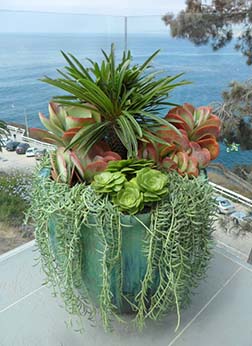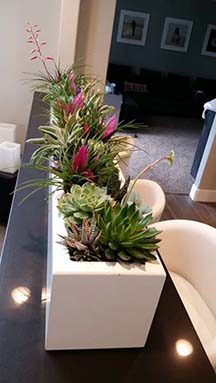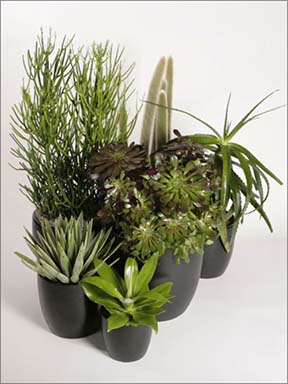Common Name: Cactus
Light Needs
Bright, direct sunlight
Water Requirements
Water sparingly
Description:
This diverse Cactaceae family varies from tiny pebble-like plants hiding in the gravel to plants 50 feet high. Their spines are generally considered to be modified leaves.
Most commonly used varieties: Saguaro and San Pedro
The diverse Cactaceae family varies from tiny pebble-like plants hiding in the gravel to plants 50 feet high. Their spines are generally considered to be modified leaves. These spines grow from small, cushion-like structures called areoles, which may be thought of as condensed lateral branches. All growth takes place from these areoles – including branches, leaves if any, wool, bristles or spines, and all flowers. Flowers are usually solitary and often large and brightly colored, though usually short lived.
The Cactaceae family loves bright, direct sunlight.
Cacti will not adapt to a weekly watering schedule. Do not give them “just a little splash” every week and expect them to do their best. In the spring, they have a natural growth cycle and this is when they will want to absorb water. When the soil is dry all the way down, water through to the saucer, but never leave them standing in water. This is the one time to give them a bit of fertilizer as well. During the winter, they need to dry to the point of shriveling. Deny them water until the soil is completely dry, and the accordion ribs show signs of contracting. This is OK; this is what they are supposed to do. Signs of overwatering can be bloated looking stems, wet surface soil or plants that want to topple over due to rotted off roots. A cactus that is chronically over-watered will one day dissolve into a stinking, slimy pile of mush.
Keep members of the Cactaceae family healthy and clean by an occasional misting with water. Do not use leaf shine, the chemicals will damage them and besides, a cactus isn’t supposed to be shiny – a dull finish is a natural look. To transport a cactus, wrap its stems with foam rubber or thick sections of newspaper to protect yourself from the thorns. Pack cardboard or newspaper tightly around the soil for support and if possible keep it vertical during the move. Disturb the roots as little as possible.
Mealybug can be a problem for a cactus, both on the stems and in the soil. Scale insects are also a problem. Watch carefully for any sign of these pests and start a hand removal of them as soon as you notice them.




